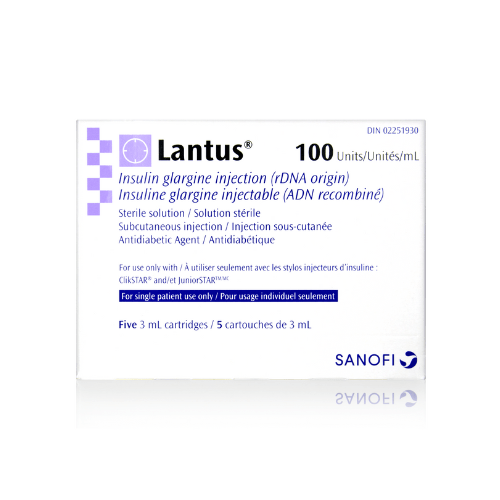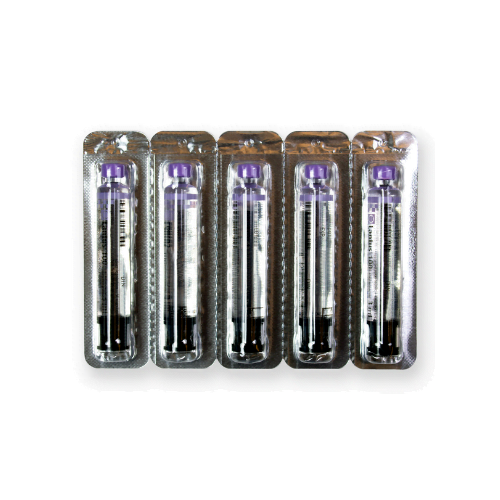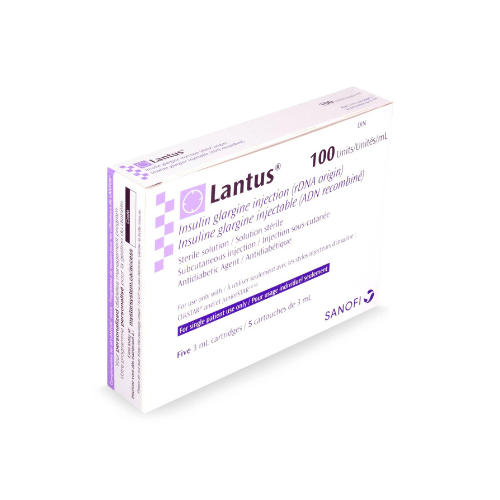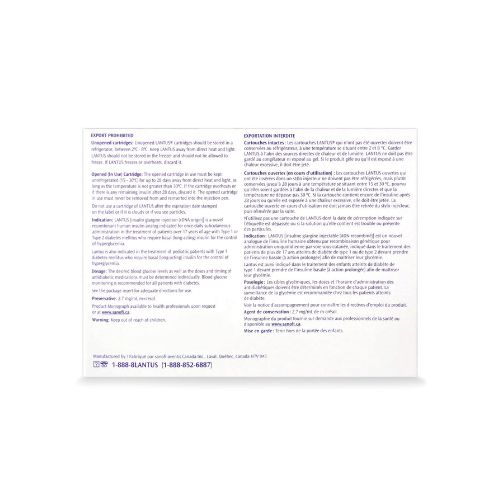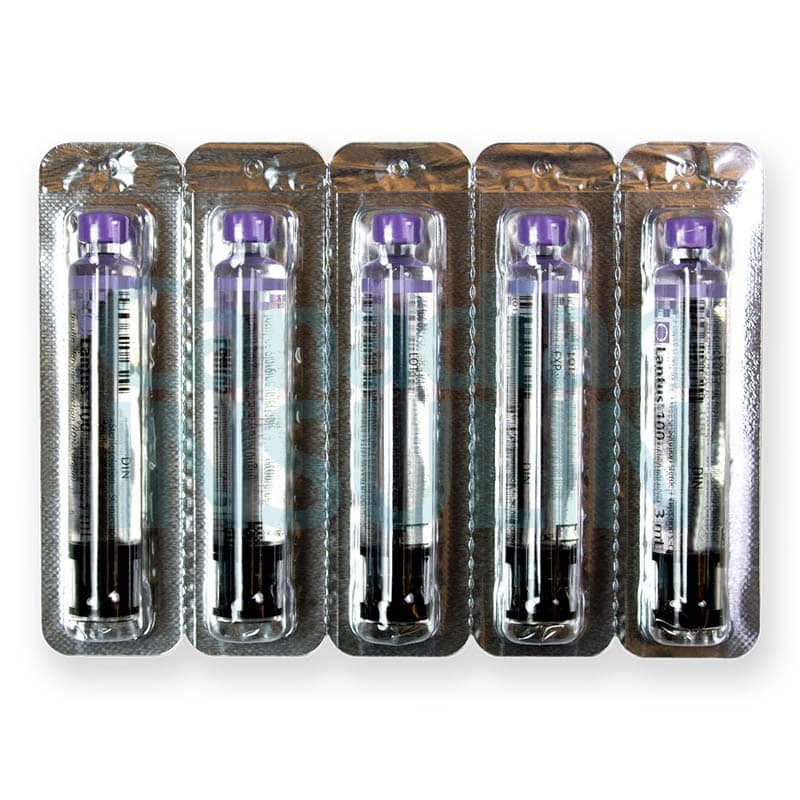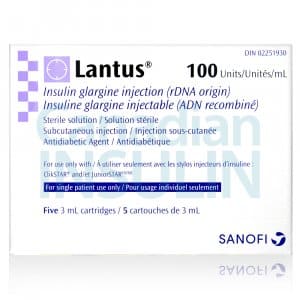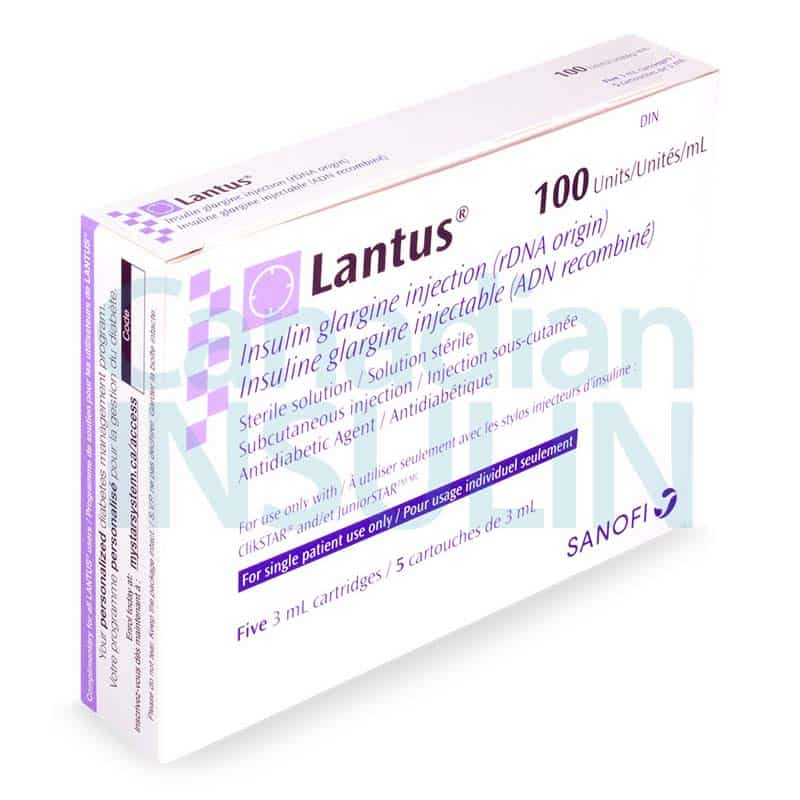Please note: a valid prescription is required for all prescription medication.
Lantus® Cartridges are insulin glargine for reusable pens, used as a once-daily basal insulin for type 1 and type 2 diabetes. Many patients choose cartridges for their compact size and steady dosing. With US delivery from Canada and Canadian pricing, it’s a straightforward way to access Lantus Cartridges, including cash-pay options for those without insurance.
What Lantus® Is and How It Works
Every CanadianInsulin order is prescription-checked with your clinic and dispensed by a licensed Canadian pharmacy.
Lantus® contains insulin glargine, a long-acting basal insulin analog. After subcutaneous injection, glargine forms a depot in the fatty tissue and is released gradually over many hours. This slow, steady absorption supports stable background insulin levels between meals and overnight.
For many, a once-daily schedule fits well into routine care. Lantus is not intended for treatment of diabetic ketoacidosis and must not be given intravenously or via an insulin pump unless specifically directed by the label. It is designed for subcutaneous use only.
Lantus is available in multiple presentations. Some prefer the convenience of prefilled Lantus Solostar Pens. Others use vials with syringes, such as the Lantus Vial. Cartridges offer a middle path for those using compatible reusable pens.
Who Lantus Is For
Lantus is indicated for adults with type 1 or type 2 diabetes who need basal insulin. It is also used in children with type 1 diabetes where approved. Suitability depends on clinical history, current therapy, and goals of care.
People with a history of severe hypoglycemia, known hypersensitivity to insulin glargine or any excipient, or those currently in diabetic ketoacidosis require different management. Caution is advised in renal or hepatic impairment, during transitions between insulin products, and when other glucose-lowering drugs are being added or adjusted. Pregnancy and breastfeeding often require careful monitoring and dose changes.
Dosage and Usage
Dosing is individualized. Many adults use Lantus once daily at the same time each day. Prescribers commonly start with a modest dose and adjust gradually based on fasting glucose patterns. If switching from another basal insulin, the label provides guidance to reduce or match the prior daily dose depending on the product being replaced. Clinicians tailor the plan to the patient’s needs and monitoring data.
Administration basics include subcutaneous injection into recommended areas (abdomen, thigh, or upper arm), with rotation of sites to reduce lipodystrophy. Do not mix or dilute Lantus with other insulins. For mealtime coverage when needed, a separate rapid-acting insulin is typically used, such as the Novorapid Cartridge chosen by many for bolus dosing.
When using a reusable pen, insert the cartridge per the pen’s instructions, attach a new needle, prime before each injection, dial the dose, inject, and hold for the recommended count before removing the needle.
Strengths and Forms
Lantus Cartridges are commonly available as 3 mL cartridges at a standard concentration; cartons typically include multiple cartridges. Availability can vary by market and time. Cartridges are intended for use only with compatible reusable pens approved for insulin glargine cartridges. For other long-acting cartridge options, browse our Long Acting Insulin Cartridges.
Missed Dose and Timing
If a dose is missed, the label generally advises taking it when remembered on the same day, then returning to the usual time the next day. Avoid taking extra doses to make up for a missed one. Because timing changes can affect blood glucose and hypoglycemia risk, the care team’s instructions should guide decisions when the next dose is near.
Storage and Travel Basics
Unopened cartridges are typically stored refrigerated until first use. In-use cartridges should be kept at room temperature per the label and protected from heat and light. Do not freeze insulin; discard if it has been frozen. Many labels allow in-use storage at room temperature for a limited period, often around four weeks, but the official instructions should be followed.
For travel, keep insulin in carry-on luggage, use an insulated case or cool packs to avoid overheating, and never place insulin directly against ice. Carry a spare pen, extra needles, and backup glucose sources. Temperature-sensitive items ship with cold-chain handling and insulated packaging.
Pen Handling and Sharps Disposal
- Use a new pen needle for every injection.
- Prime the pen per the manufacturer’s instructions before dialing the dose.
- Never share pens or needles, even after changing the needle.
- Store the pen and cartridge according to the label and keep caps on when not in use.
- Remove and safely discard needles immediately after injection.
- Dispose of used needles and lancets in an approved sharps container; follow local guidance for disposal or drop-off.
Benefits
Lantus provides steady basal insulin coverage designed to help manage fasting and between-meal glucose. The once-daily schedule can simplify routines and support adherence. A predictable activity profile allows clinicians to titrate gradually to reach personalized targets.
Cartridges let experienced pen users combine the familiarity of a reusable pen with the reliability of Lantus. For those already comfortable with a reusable pen platform, cartridges minimize plastic waste and may simplify packing for travel.
Side Effects and Safety
- Hypoglycemia, ranging from mild to severe
- Injection-site reactions (redness, itching, discomfort)
- Lipodystrophy or localized skin changes with repeated injections
- Edema and weight changes
- Allergic reactions, including rash or pruritus
Serious but less common risks include severe hypoglycemia, significant hypersensitivity, and hypokalemia. Rapid improvements in glucose control can cause temporary vision changes or peripheral edema in some patients. Concomitant use of thiazolidinediones may increase the risk of fluid retention and heart failure; clinicians monitor closely when combining therapies.
Drug Interactions and Cautions
- Medicines that may increase glucose (e.g., corticosteroids, certain diuretics, some antipsychotics): insulin needs may rise.
- Medicines that may lower glucose (e.g., salicylates, some GLP-1 RAs, SGLT2 inhibitors): insulin needs may fall.
- Beta blockers and similar agents can mask hypoglycemia warning symptoms.
- Alcohol can raise or lower glucose unpredictably; use caution.
- Thiazolidinediones with insulin: monitor for edema and signs of heart failure.
- Illness, changes in activity, or diet can require dose adjustments.
What to Expect Over Time
Basal insulin therapy is typically adjusted in small steps to balance fasting glucose and minimize lows. As the plan settles, many patients notice steadier mornings and fewer overnight fluctuations. A1C changes reflect weeks to months of consistent use. Technique, site rotation, and regular monitoring all support safer titration.
Therapy often evolves. Mealtime insulin, non-insulin agents, or technology such as continuous glucose monitoring may be added as goals change. Periodic reviews with the care team help keep the plan aligned with daily life.
Compare With Alternatives
Several long-acting options may be considered alongside Lantus. A closely related alternative is insulin glargine from another manufacturer. For example, Basaglar Cartridges provide a glargine formulation with similar use in basal regimens. Ultra-long options like insulin degludec may offer even longer duration; many prefer the pen-based Tresiba Flextouch Pens.
Some patients require different concentrations or profiles. Providers may consider more concentrated glargine (e.g., products formulated for smaller injection volumes) or detemir-based regimens in specific circumstances. Final selection reflects clinical goals, insurance coverage, and device preferences.
Pricing and Access
Many customers choose cross-border ordering to benefit from Canadian pricing on brand-name insulin. We provide US delivery from Canada with prompt, express, cold-chain shipping. Self-pay buyers and those without insurance often find meaningful savings compared with typical US cash prices, though actual costs vary by quantity and device.
To explore current savings opportunities, see our Promotions. Pricing and eligibility are subject to change based on supply and verification requirements.
Availability and Substitutions
Product availability can change. If Lantus Cartridges are temporarily unavailable, a prescriber may recommend a clinically suitable alternative, such as a concentrated glargine presentation like the Toujeo Doublestar Prefilled Pen or a detemir formulation like Levemir Penfill Cartridges. Any switch should follow label guidance and medical supervision.
Patient Suitability and Cost-Saving Tips
Good candidates for Lantus include those who need basal insulin to support fasting and between-meal control. People who prefer reusable pens and cartridge-based systems may appreciate the familiar handling. Those with frequent severe hypoglycemia, recurring injection-site reactions, or a history of insulin allergies may require adjustments or a different product.
- Ask about multi-month supplies to reduce per-shipment costs.
- Align refills with clinical follow-ups for efficient dose reviews.
- Rotate injection sites to protect skin and maintain absorption.
- If switching products, confirm the new dose and timing plan before the first injection.
- Keep a simple log of fasting readings to support careful titration.
Questions to Ask Your Clinician
- What starting dose and titration plan fits my current regimen?
- Which compatible reusable pen should be used with these cartridges?
- How should I adjust basal insulin when illness or schedule changes occur?
- What signs of hypoglycemia should be watched for, and how should lows be treated?
- Should a mealtime insulin be added, and if so, which type?
- Are there reasons to consider alternatives like degludec or concentrated glargine?
- What storage plan is best for home and travel?
Authoritative Sources
- Lantus Prescribing Information (Sanofi US)
- Health Canada Product Monograph: Lantus
- American Diabetes Association: Insulin Basics
Ready to request Lantus Cartridges through CanadianInsulin? Order with confidence and benefit from prompt, express, cold-chain shipping to the US from Canada.
Disclaimer: This information is educational and not a substitute for professional medical advice. Always follow the advice of your prescriber and the approved product labeling.
Express Shipping - from $25.00
Shipping with this method takes 3-5 days
Prices:
- Dry-Packed Products $25.00
- Cold-Packed Products $35.00
Standard Shipping - $15.00
Shipping with this method takes 5-10 days
Prices:
- Dry-Packed Products $15.00
- Not available for Cold-Packed products
What are Lantus Cartridges?
They are insulin glargine cartridges used in compatible reusable pens to provide once-daily basal insulin support. Lantus Cartridges are designed for subcutaneous injection and should not be mixed or diluted.
Which pens are compatible with Lantus Cartridges?
Use only manufacturer-listed reusable cartridge pens that are approved for insulin glargine cartridges. Always check the pen’s instructions to confirm compatibility before inserting a new cartridge.
How should Lantus Cartridges be stored?
Unopened cartridges are usually kept refrigerated. In-use cartridges are kept at room temperature away from heat and light and must not be frozen. Follow the label for in-use time limits and handling details.
Can Lantus be mixed with other insulins?
No. Lantus is not designed to be mixed with or diluted by other insulins. If mealtime coverage is needed, a separate rapid-acting insulin is typically used as directed by the prescriber.
Do I need a prescription to buy Lantus Cartridges?
Yes. Lantus is a prescription medicine, and a valid prescription is required before dispensing.
Do you ship to the United States?
Yes. Orders are fulfilled with US delivery from Canada and handled with prompt, express, cold-chain shipping. No delivery timelines are stated here.
What should I do if I miss a dose?
General labels advise taking the missed dose when remembered on the same day and returning to the usual time the next day. Do not double up; ask the care team for personalized guidance.
Rewards Program
Earn points on birthdays, product orders, reviews, friend referrals, and more! Enjoy your medication at unparalleled discounts while reaping rewards for every step you take with us.
You can read more about rewards here.
POINT VALUE
How to earn points
- 1Create an account and start earning.
- 2Earn points every time you shop or perform certain actions.
- 3Redeem points for exclusive discounts.
You Might Also Like
Related Articles
Join the Cause: American Diabetes Month 2025
Every November, millions of Americans come together to shine a light on one of the country’s most pressing health challenges — diabetes. American Diabetes Month is more than just a…
Orforglipron vs Rybelsus: Which Is More Effective?
According to the International Diabetes Federation (IDF), around 589 million adults aged 20–79 are living with diabetes globally. This marks the need for immediate medical action and treatment. Fortunately, with…
How to Travel with Ozempic: Keep Your Dose Effective
Vacations, business trips, and weekend getaways shouldn’t interfere with your health routine. For people using Ozempic, planning ahead is key to keeping your medication safe and effective while on the…
What Is Onsior Cat Medicine Used For?
If your cat has ever had surgery, dental work, or an injury, you know how vital pain relief can be for recovery and comfort. Onsior cat medicine is a veterinary-approved…

